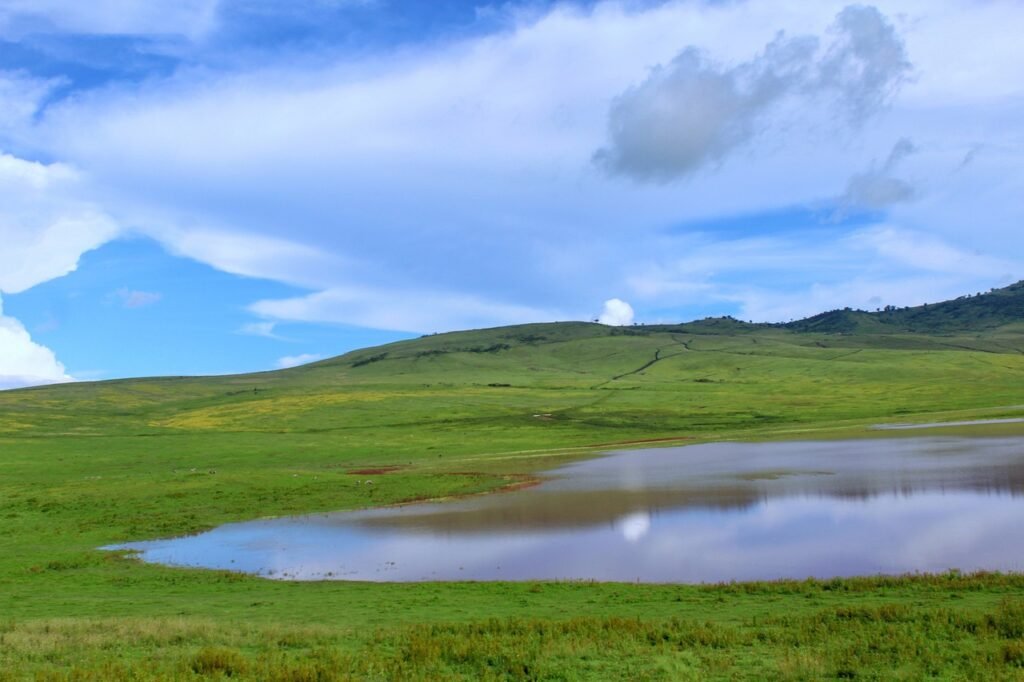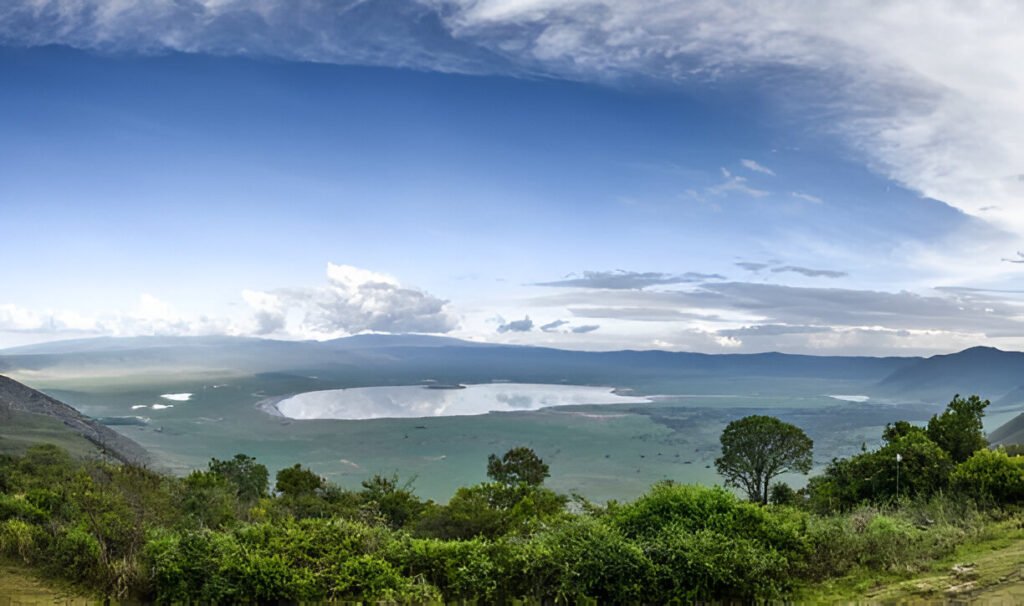Ngorongoro Crater Entrance Fees 2025/2026 : Ngorongoro Crater is a breathtaking wonder located in northern Tanzania, renowned for its rich biodiversity and spectacular landscapes. This UNESCO World Heritage site is one of Africa’s top safari destinations, offering visitors the chance to witness a variety of wildlife, including the “Big Five,” all within the crater’s unique ecosystem. Before planning your trip, it’s essential to know the entrance fees and permits required for access to Ngorongoro Conservation Area, ensuring a smooth and well-prepared safari experience.
Learn more about safaris in Tanzania and the Ngorongoro area.

Ngorongoro Crater Entrance Fees 2025/2026 : What is Ngorongoro Crater?
Ngorongoro Crater, often referred to as the “Eighth Wonder of the World,” is the world’s largest inactive volcanic caldera. Formed millions of years ago, the crater is 610 meters deep and spans over 260 square kilometers. Its diverse ecosystem supports over 25,000 large animals, including elephants, rhinos, lions, and wildebeest, making it one of the best places to see wildlife in Africa.
The crater floor is a haven for wildlife, featuring open grasslands, swamps, lakes, and forests. Each habitat attracts different animals, from grazing herbivores to predatory lions, making it an ideal location for an unforgettable safari.
Explore the fascinating geology and history of Ngorongoro Crater here.
Ngorongoro Crater Entrance Fees 2025/2026 : Updated Ngorongoro Crater Entrance Fees for 2025
As of 2024, the Ngorongoro Conservation Area Authority has updated the entrance fees for tourists visiting the crater. These fees are crucial to maintaining the conservation efforts and facilities that help preserve this natural wonder.
Key Fees to Consider:
- Ngorongoro Conservation Area Entry Fee:
- $70 USD per adult per day.
- Children (5-16 years): $20 USD per day.
- Vehicle Entry Fee:
- $40 USD per vehicle per day (based on vehicle size and type).
- Crater Service Fee (for descending into the crater):
- $295 USD per vehicle per day.
- Mandatory for all visitors descending into the crater floor.
For full details on updated entrance fees, check the official page here.
Ngorongoro Crater Entrance Fees 2025/2026 : Additional Costs and Permits
In addition to the entrance fees, there are other costs to consider when visiting Ngorongoro Crater:
- Camping Fees: If you’re planning to camp in the area, fees vary depending on the location and level of facilities provided. Basic camping starts at $30 USD per person, while luxury campsites may charge up to $100 USD or more per person.
- Walking Safaris: Ngorongoro Conservation Area offers guided walking safaris, providing a different perspective of the landscape. Fees for walking safaris range from $50 to $100 USD per person, depending on the route and duration.
- Cultural Fees: Visitors can also explore the local Maasai villages within the conservation area. Cultural tours often cost around $20 to $50 USD per person, providing a unique insight into the Maasai’s traditional way of life.
Find more information on cultural tours in Ngorongoro Crater.
Ngorongoro Crater Entrance Fees 2025/2026 : How to Pay Ngorongoro Crater Entrance Fees
All payments for Ngorongoro Crater entrance fees must be made electronically via the Ngorongoro Conservation Area Authority’s official channels. Cash payments are generally not accepted, so ensure you have a valid credit or debit card on hand.
Many safari operators include these fees in their package prices, so double-check with your tour company to avoid paying twice.
Get detailed payment options for Ngorongoro Crater entrance fees here.
Ngorongoro Crater Entrance Fees 2025/2026 : Best Time to Visit Ngorongoro Crater
Ngorongoro Crater is a year-round destination, but depending on your preferences, certain months offer specific benefits:
- Dry Season (June to October): The best time for wildlife viewing. Animals are easier to spot due to the thin vegetation, and predators are more active around waterholes.
- Wet Season (November to May): Lush landscapes and fewer tourists make this season appealing, though roads can be more challenging due to rain. This is also the time when migratory birds flock to the crater.
Explore when to visit the Ngorongoro Crater for the best wildlife experiences.
Wildlife You Can Expect to See
Ngorongoro Crater is home to one of the densest populations of wildlife in Africa, making it a prime spot for game viewing. Some of the animals you’re likely to encounter include:
- African Elephant: Large herds roam the crater floor, especially around swampy areas.
- Black Rhinoceros: The crater is one of the few places in Tanzania where you can see the critically endangered black rhino.
- Lions: Ngorongoro boasts a healthy lion population, often seen resting in the shade during the day.
- Wildebeest and Zebras: Large herds of wildebeest and zebras are permanent residents of the crater.
- Hippos: Lake Magadi, found within the crater, is a popular spot for hippos to gather.
For more detailed information about the wildlife of Ngorongoro, visit this comprehensive wildlife guide.
How to Maximize Your Ngorongoro Crater Experience
To make the most of your trip to Ngorongoro, it’s essential to plan your visit strategically. Here are some tips for ensuring you get the best out of your safari experience:
- Start Early: The crater gets crowded as the day progresses, so it’s best to descend early in the morning for a peaceful and quiet experience.
- Hire an Experienced Guide: Having a knowledgeable guide is crucial for spotting wildlife and understanding the area’s ecology.
- Pack the Right Gear: Bring binoculars for wildlife viewing, a camera for stunning landscapes, sunscreen, and appropriate safari clothing.
For more safari preparation tips, visit this useful travel resource.
Conservation Efforts in Ngorongoro Crater
Ngorongoro Conservation Area is not only a haven for wildlife but also an important cultural and ecological site. Conservation efforts focus on preserving the area’s biodiversity, protecting endangered species, and promoting sustainable tourism. Anti-poaching initiatives and local community involvement are vital components of this work.
In recent years, there has been an increasing emphasis on balancing tourism with the need to protect the area’s fragile ecosystem. Visitors are encouraged to follow eco-friendly practices, such as minimizing waste, staying on designated paths, and respecting wildlife.
Learn more about ongoing conservation projects in Ngorongoro.
Other Attractions Near Ngorongoro Crater
While the crater itself is the main attraction, the surrounding Ngorongoro Conservation Area offers other exciting places to explore:
- Olduvai Gorge: Known as the “Cradle of Mankind,” this archaeological site is where some of the earliest human remains were discovered.
- Empakaai Crater: A smaller but equally stunning crater located northeast of Ngorongoro Crater. It’s a great spot for hiking and bird watching.
- Ndutu Plains: Located in the southern part of the conservation area, the Ndutu region is famous for being a key calving area during the Great Migration.
For more on other must-see spots in the region, check out this travel guide.

Ngorongoro Crater Entrance Fees 2025/2026 : Conclusion
Visiting Ngorongoro Crater offers an unparalleled safari experience, filled with incredible wildlife sightings, dramatic landscapes, and rich cultural history. By understanding the entrance fees, permits, and other logistical details, you can make the most of your trip and enjoy everything this unique conservation area has to offer.
Check out more detailed guides and tips for your Ngorongoro Crater safari here or plan your trip with the help of Eddy Tours & Safaris.

